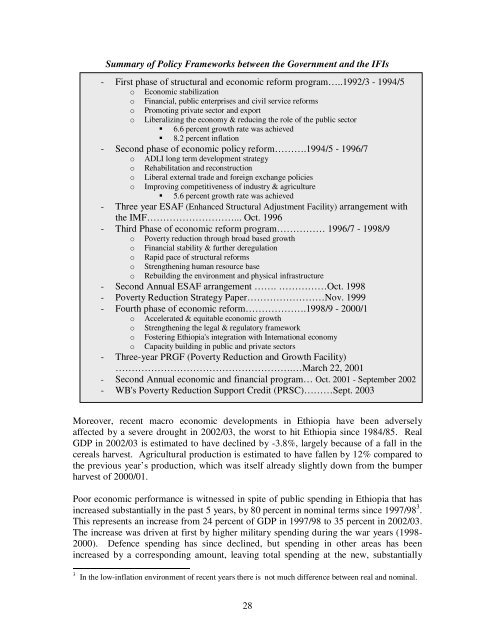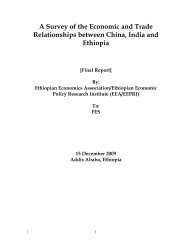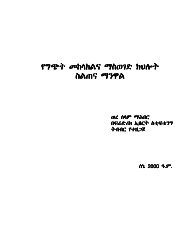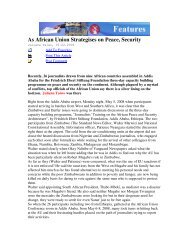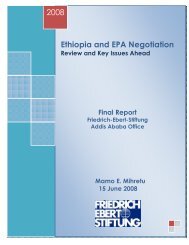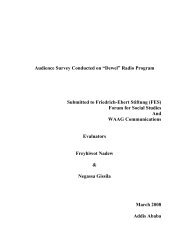external influence in the making of development ... - FES Ethiopia
external influence in the making of development ... - FES Ethiopia
external influence in the making of development ... - FES Ethiopia
Create successful ePaper yourself
Turn your PDF publications into a flip-book with our unique Google optimized e-Paper software.
Summary <strong>of</strong> Policy Frameworks between <strong>the</strong> Government and <strong>the</strong> IFIs<br />
- First phase <strong>of</strong> structural and economic reform program…..1992/3 - 1994/5<br />
o Economic stabilization<br />
o F<strong>in</strong>ancial, public enterprises and civil service reforms<br />
o Promot<strong>in</strong>g private sector and export<br />
o Liberaliz<strong>in</strong>g <strong>the</strong> economy & reduc<strong>in</strong>g <strong>the</strong> role <strong>of</strong> <strong>the</strong> public sector<br />
6.6 percent growth rate was achieved<br />
8.2 percent <strong>in</strong>flation<br />
- Second phase <strong>of</strong> economic policy reform……….1994/5 - 1996/7<br />
o ADLI long term <strong>development</strong> strategy<br />
o Rehabilitation and reconstruction<br />
o Liberal <strong>external</strong> trade and foreign exchange policies<br />
o Improv<strong>in</strong>g competitiveness <strong>of</strong> <strong>in</strong>dustry & agriculture<br />
5.6 percent growth rate was achieved<br />
- Three year ESAF (Enhanced Structural Adjustment Facility) arrangement with<br />
<strong>the</strong> IMF………………………... Oct. 1996<br />
- Third Phase <strong>of</strong> economic reform program…………… 1996/7 - 1998/9<br />
o Poverty reduction through broad based growth<br />
o F<strong>in</strong>ancial stability & fur<strong>the</strong>r deregulation<br />
o Rapid pace <strong>of</strong> structural reforms<br />
o Streng<strong>the</strong>n<strong>in</strong>g human resource base<br />
o Rebuild<strong>in</strong>g <strong>the</strong> environment and physical <strong>in</strong>frastructure<br />
- Second Annual ESAF arrangement ……. ……………Oct. 1998<br />
- Poverty Reduction Strategy Paper……………………Nov. 1999<br />
- Fourth phase <strong>of</strong> economic reform……………….1998/9 - 2000/1<br />
o Accelerated & equitable economic growth<br />
o Streng<strong>the</strong>n<strong>in</strong>g <strong>the</strong> legal & regulatory framework<br />
o Foster<strong>in</strong>g <strong>Ethiopia</strong>'s <strong>in</strong>tegration with International economy<br />
o Capacity build<strong>in</strong>g <strong>in</strong> public and private sectors<br />
- Three-year PRGF (Poverty Reduction and Growth Facility)<br />
……………………………………………….…March 22, 2001<br />
- Second Annual economic and f<strong>in</strong>ancial program… Oct. 2001 - September 2002<br />
- WB's Poverty Reduction Support Credit (PRSC)………Sept. 2003<br />
Moreover, recent macro economic <strong>development</strong>s <strong>in</strong> <strong>Ethiopia</strong> have been adversely<br />
affected by a severe drought <strong>in</strong> 2002/03, <strong>the</strong> worst to hit <strong>Ethiopia</strong> s<strong>in</strong>ce 1984/85. Real<br />
GDP <strong>in</strong> 2002/03 is estimated to have decl<strong>in</strong>ed by -3.8%, largely because <strong>of</strong> a fall <strong>in</strong> <strong>the</strong><br />
cereals harvest. Agricultural production is estimated to have fallen by 12% compared to<br />
<strong>the</strong> previous year’s production, which was itself already slightly down from <strong>the</strong> bumper<br />
harvest <strong>of</strong> 2000/01.<br />
Poor economic performance is witnessed <strong>in</strong> spite <strong>of</strong> public spend<strong>in</strong>g <strong>in</strong> <strong>Ethiopia</strong> that has<br />
<strong>in</strong>creased substantially <strong>in</strong> <strong>the</strong> past 5 years, by 80 percent <strong>in</strong> nom<strong>in</strong>al terms s<strong>in</strong>ce 1997/98 3 .<br />
This represents an <strong>in</strong>crease from 24 percent <strong>of</strong> GDP <strong>in</strong> 1997/98 to 35 percent <strong>in</strong> 2002/03.<br />
The <strong>in</strong>crease was driven at first by higher military spend<strong>in</strong>g dur<strong>in</strong>g <strong>the</strong> war years (1998-<br />
2000). Defence spend<strong>in</strong>g has s<strong>in</strong>ce decl<strong>in</strong>ed, but spend<strong>in</strong>g <strong>in</strong> o<strong>the</strong>r areas has been<br />
<strong>in</strong>creased by a correspond<strong>in</strong>g amount, leav<strong>in</strong>g total spend<strong>in</strong>g at <strong>the</strong> new, substantially<br />
3 In <strong>the</strong> low-<strong>in</strong>flation environment <strong>of</strong> recent years <strong>the</strong>re is not much difference between real and nom<strong>in</strong>al.<br />
28


